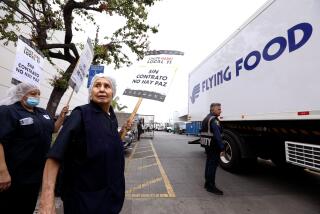BUSINESS PULSE : SMALL BUSINESS IN ORANGE COUNTY : Big or Small Firm? Worker Rewards Differ : Insurance, Other Extras--but Less Flexibility--Come With Larger Companies
Here’s the scenario: You’re looking for a job at a retail firm, and you have two offers, one from a small, mom-and-pop clothing store and another from a major chain. Which job do you take?
If you want to work for higher wages, have medical coverage and a pension plan for your old age, your best bet might be to think big, as in Big Business. But if friendliness, flexibility and potential opportunity are high on your priority scale, less can indeed be more in Orange County’s burgeoning small-business sector.
But beware: While some at large corporations fret about perks like fitness programs, workers at small businesses often go without basic medical coverage. And outright worker abuse--ranging from non-payment of wages to forced overtime--is more prevalent at small companies.
It’s not that small-business owners necessarily take management training from Simon Legree. The major problem is profitability, a state of being that many small businesses find elusive.
“Regardless of the employee benefits you’re talking about, you have to be a profitable company to offer them,” said Frank Swain, chief counsel for advocacy at the U.S. Small Business Administration. “Small firms and new firms don’t have adequate revenues and profits to offer employee benefits.”
Little wonder. The Orange County Business Development Center says that 72% of all new business starts will fail within their first three years. Nationally, 88% of small-businesses start-ups fail to celebrate their third birthday, according to the Department of Commerce.
But it’s not all sack cloth and ashes in the land of the entrepreneur. Small companies often offset low wages and limited benefits with increased flexibility in such things as work schedules. And federal studies show that the women and men hired by small businesses are getting breaks that are next to non-existent in larger firms.
“By employing workers with little or no prior work experience, small firms improve the sustained employment prospects of these workers,” says the 1987 “State of Small Business: A Report of the President.”
But in more tangible areas such as health insurance, paid vacations, retirement programs and sick leave, small businesses are outclassed by their bigger counterparts. Consider the results of a nationwide study by the Washington-based Employee Benefits Research Institute:
- Retirement programs are offered by 91% of companies with 100 or more workers, compared to only 43% of firms with fewer than 100 employees.
- A full 99% of the larger firms give paid vacations, while only 81% of the smaller companies pay for such breaks.
- Paid sick leave is a reality in 67% of large companies, but only 46% of smaller ones.
What does this mean for Orange County? Of the areas’s approximately 80,000 businesses, 96% have 50 or fewer workers. So benefits taken for granted by employees of, say, Rockwell International or Fluor Corp., are simply not an option for many county workers.
And the smaller the business, the fewer benefits its workers tend to receive.
Among participants in The Times Small Business Poll, 44% of firms with five or fewer workers offer no health insurance. In contrast, only 6% of firms with 26 to 50 workers have no health care coverage.
After paid vacations, health insurance is the benefit most demanded by workers, according to the SBA’s Swain. And it’s the one that presents perhaps the biggest dilemma for small business owners.
“Small employers feel like they want to offer health insurance,” Swain said. “Employees are increasingly demanding health insurance. But it’s the benefit that’s going up in cost the most.”
The eight full-time workers at Camelot Research Corp. in Anaheim are enjoying health insurance for the first time in the company’s 5-year history. It took until 1989 for the company, which sells computerized foreclosure listings, to make enough money to cover the $1,000 monthly premium payments.
“We started off not offering benefits at all in the beginning,” Camelot owner Ronald M. Frumkin said. “Within the first 6 months, we started offering paid holidays. Then we also gave them a week’s vacation. This is the first year we’ve offered health insurance.”
The altruistic side of Frumkin wanted to offer insurance as a way to “share the wealth” of his now-prosperous company. The pragmatic side realized that insurance is an important hiring and retention tool, even though he will pay dearly for it. The SBA estimates that employer health insurance costs are rising about 30% each year.
“Getting employees is not the problem,” Swain said. “It’s finding the good ones, people who care about the quality of the job. . . . When I do find them, I do anything I can to keep them.”
Part-time labor is another issue that tends to separate small-business employment from work at larger firms. Part-time workers are generally paid less and denied benefits. At companies with fewer than 100 workers, nearly 20% of the labor pool works fewer than 20 hours, according to the SBA. At companies with 100 or more workers, only 8% are employed part time.
And then there’s the paycheck. At companies with fewer than 100 workers, 40% of the work force earns less than $5 per hour, the SBA said, while only 19% makes $10 or more. At larger firms, about 20% of the workers make less than $5 per hour, while nearly 40% earn $10 or more.
While big corporations have been criticized for workplace problems like the so-called glass ceiling--an invisible barrier to promotion of women and minorities--smaller companies are fraught with more fundamental worker abuses.
In the 12 months ended July 31, workers filed 153 complaints with the Orange County Human Relations Commission, which tracks such problems as unpaid wages, forced and unpaid overtime, poor working conditions and failure to provide mandated workers compensation and unemployment insurance.
That number is triple the estimated 50 cases filed in 1985, the first year of the commission’s concerted effort to reach local workers, educate them about their rights and intercede on their behalf.
What kind of businesses treat their workers so badly? It’s impossible to generalize, said Barbara Considine, the Human Relations Commission’s employment specialist. But the workers who have come to her have all been employed by small, marginal companies.
“I never see someone come in here accusing Xerox or the Irvine Co.,” Considine said. “I tend to get people who work for very small companies, businesses that are struggling themselves. . . . But that’s no excuse. If you can’t pay your workers, you shouldn’t be in business.”
Last October, Martin Alanis and his cousin, Jose A. Escobedo, were promised $5 an hour for remodeling and repairing homes as members of a four-man work team hired by a construction company. For four weeks, they worked primarily in Santa Ana repairing two homes, said Alanis, 18, who supports a wife and 4-month-old son in Mexico City.
“He did pay us, but only once when he wrote a check to Jose,” Alanis said. “But when Jose took it to the bank they later told him there were no funds to pay for it on the account it was written on.”
Alanis said the owner of the construction company owes him about $500 and owes Escobedo at least $700. In December, Alanis and Escobedo complained to the Human Relations Commission, and Considine contacted the owner.
“I talked to the employer, who admitted hiring them,” she said. “He told me he was doing them a favor by teaching them a trade. He said, ‘I’ll pay them when I get the money, but I just don’t have it.’ ”
The telephones at the construction company have been disconnected, and the owner could not be reached for comment. Considine said she referred Alanis and Escobedo to the State Labor Commission to file a complaint.
But not all small companies are borderline bankruptcies, and many make a great effort to do what they can for their workers.
Tim Millsaps is vice president of national sales for Kanvas by Katin and will soon be co-owner. Millsaps admits that “being a small business makes it difficult to offer good benefits.”
In an effort to ensure health insurance for the surf-wear company’s seven workers, Kanvas by Katin joined an employee leasing firm, which pays the workers and covers their insurance needs for a fee, which is lower than Kanvas would have to pay for insurance alone.
In addition, several of the firm’s seamstresses work at home, and the company offers unpaid leave to allow for childbirth and continuing education.
“They get exactly the same job they had before when they come back,” Millsaps said. “We have a guy right now who took a year’s leave of absence for school. He’ll come back no worse off--and possibly better, depending on how he does at school.”
And then there’s Kanvas by Katin’s special brand of flex time.
“In the morning, the employees surf,” said Millsaps, an inveterate surfer himself. “On Sunday, I made a corporate decision in the water off Surfside. I decided to open up an hour later, at 10 a.m. instead of 9 a.m. One of my employees was out surfing with me and was a real happy camper.”
Times staff writer David Reyes contributed to this report.
WORKERS Medical Insurance
“Are employees in your business offered health insurance coverage?”
Employees No Yes 1-5 16% 84% 6-10 44% 56% 11-25 9% 91% 26-50 6% 94%
Source: Times Small Business Poll
More to Read
Inside the business of entertainment
The Wide Shot brings you news, analysis and insights on everything from streaming wars to production — and what it all means for the future.
You may occasionally receive promotional content from the Los Angeles Times.











